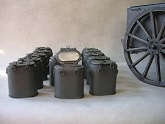German Army food containers were specially designed to store and transport military food products, such that they were well-preserved and palatable, with all the nutrients. Read our guide for more facts and information…
Food supply happens to pose a great challenge while maintaining a large standing army. During the First World War, food supply to trenches was almost a luxury, as transporting food from the field kitchens to the soldiers at the frontline trenches was almost impossible when the battle was in full swing or imminent. When they were at stand-down, they could expect to get food more frequently. Therefore, army rations of various types were packaged in specialized army containers for distribution in the field. The theoretical rations for German soldiers include bread, field biscuits, egg biscuits, potatoes, dried vegetables, refrigerated foods, canned meat and high-calorie chocolate bars.
Description of German Army food containers
Food containers of the German Army comprised hinged lids with latches to clamp the lids down, and they had leather backpack straps. They had carrying handles on the side and an opening handle on the lid. They were thermo containers, comprising an outer container surrounding an inner one, with air space in between to serve as insulation. Some of them had rings at the corners for harnesses. They had compartments inside to keep liquids and solids separately. Weighing about 18 pounds, each of them had a capacity of about 12 liters.
The German Army field kitchen
The remote field kitchen of the German Army, known as Gulasch-Kanone, was a spoke-wheeled kitchen vehicle. The word ‘Gulasch-Kanone’ refers to ‘Stew-gun’ and the kitchen was called so because it resembled an artillery piece when the chimney was withdrawn for transport. Large kitchens supported about six food containers, while smaller ones could replenish four containers. The kettenkrad or tracked military motorcycles transported the thermo-containers to supply food for the troops.
Various food containers used in the field
Wehrmacht food containers were particularly used for pre-packed rations during the Second World War. The German Army iron ration namely, Eiserne Portionen consisted of hard biscuits, tinned meat and tinned soup. Tinned food was not used during peacetime as it was cheaper to supply food directly from the rolling kitchen. The packaging containers were made from several materials such as tin cans, cellophane, glass, cardboard as well as wood. The Afrika Korps food container was designed for transporting warm food or beverages from the field kitchen.
The Food Container Institute of the US Army tested more than a hundred food items used in the German ration, and evaluated the container materials in 1947. Wehrmacht containers and packages were designed for various kinds of rations like arctic survival rations, tank crew rations and paratroop rations, and for alcoholic beverages. A specially made trademark cylindrical can was used to pack Scho-Ko-Kola, a high-energy chocolate candy.
German Army food containers are valued as collectibles, and though inedible the tinned meat cans are sold at a good price for collectors. The rare insulated containers are quite useful for backpacking and are prized possessions for war survivors and collectors.




